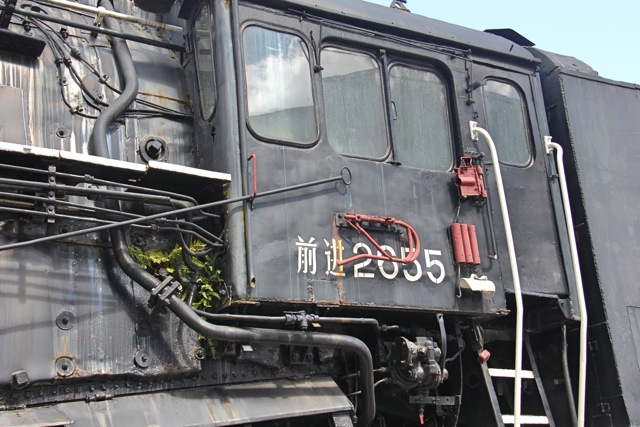Hi all, thank you for reading the first part of my review of “Technikmuseum Speyer”. This is the second part.
When leaving the first hall, you should turn right. In the narrow space between fence and the building, you can see a few locomotives. In the furthest space, there is a Chinese steam powered one which is really really huge. Some plants, crawling out from the edges, create a still life which contrasts with the massive power of the machine. My favourite on tracks is the German V200 (represented by the successor V220) which looks as if if it had been designed by a comic artist.

As it is known from the main museum in Sinsheim, many planes can be seen from inside after taking a long stairway to the sky. From the outside just a small city hopper, the special version of the Antonow AN-26, surprises by carrying a fully operation GAZ-13 Tschaika V8 diplomat’s car inside. The government of the German Democratic Republic preferred to use their own cars when visiting other countries.
Taking the tour anti-clockwise you come across other trains, coaches, crawlers, a dumper, and various smaller planes like a stripped Lockheed F-104 Starfighter, placed on your way to a bigger outdoor area.
Probably the biggest plane here is the well known Boeing 747, followed by the “small” Antonow transporter – the AN-22. Even if just 2/3 of the size of the famous AN-225 Mrija, the size is more than impressive. Built in 1966, it was the biggest plane and was designed to carry freight even soil for road construction. Its landing gears can be retracted individually. Powered by four turboprop engines with two counter-rotating airscrews, the flying giant can reach 740 km/h, which is very close to the physically limited maximum speed of airscrew powered planes. Used for military service as well, it was the first plane to carry a T-62 tank which is easily imaginable when standing inside and when admiring the huge space.
The opposite of spacious is the helicopter that hides behind it: A Mil MI-24. Everyone who has seen the Rambo movies, gets the creeps by just seing the silhouette. In my imagination, it was a really massive helicopter, however it is just 17.3 m long and the cabin is just 1.47 m wide. How can it carry so many weapons, 2 crew members and 8-10 soldiers?

Between a shack with boat miniatures that is worth a visit and a sea rescue service ship, another sea rescue vehicle can be seen. The seaplane Dornier DO-24 lost the bidding against its competitor Blohm&Voss with its BV 138 in 1937. However the Dutch Marine Luchtvaartdienst MDL ordered some machines. The great performance of the construction made it ideal for sea rescue service, so that the last machines were used in the 1970s. Contemporary studies use one plane as a platform for modern research.
A submarine U-9 (German 205 class), which was in service between 1967 and 1993, finishes the nautic zone.
Which medium is missing? We had vehicles for roads, tracks, in and under water and in the air. Just aerospace is missing! Surprisingly, the museum has acquired one of the not well known Buran. At first glance, it looks like the Space Shuttle, which is not surprising as the Buran was developed as a response to it. However there were differences. The Buran was the only space ship that could start and land just like an airplane. For space flight, it would be mounted on a rocket of course. Therefore it didn’t have an own rocket engine like the Space shuttle. However this enhanced the carrying capacity by 5 tons. Due to the huge amount of money the project consumed, only one unmanned space flight was performed and just two orbiters were completed whereas three more were not finished. The last picture shows just a small piece of the complexity of this space ship.

I want to finalize my report with a car. But what would be the culmination? Located right under the Buran, it’s a Mercedes-Benz 500K with a reproduction of a streamline body from Erdmann & Rossi, produced for the king of Irak in 1935. Covering even the front wheels might look a little strange, but in my eyes it’s just the progression of the idea of a streamlined shape which led to the 1939 Bugatti Type 57C Cabriolet Vanvooren and reached its climax in the Delahaye 165.

